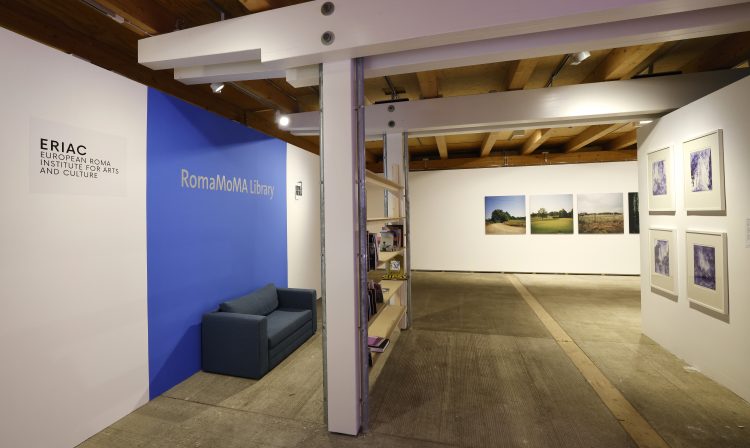RomaMoMA Nomadic Library as A Roma Contribution for Europe

RomaMoMA Nomadic Library at Schafhof: the European Center for Art Upper Bavaria. Photo: Marco Einfeldt, Schafhof.
The RomaMoMA Nomadic Library, initiated on the 50th anniversary of the First World Roma Congress, on International Roma Day, 8 April 2021, is currently on view at Schafhof: the European Center for Art Upper Bavaria, within the framework of the exhibition, Art and Healing – A Roma Contribution for Europe.
Alongside the RomaMoMA Library, featured artists are: Valérie Leray (F), Selma Selman (BIH), Dan Turner (UK), Alfred Ullrich (D).
RomaMoMA Nomadic Library
ERIAC has created a library of approximately 100 English-language books focusing on Roma Art History and Roma Cultural History, which is intended as a space to preserve, collect and showcase contemporary Roma literary and artistic heritage.
This is a “library on the road” that can be hosted by different institutions, not a physical brick-and-mortar site provided by ERIAC.
This library is not to be understood as a classical library that exclusively collects and preserves books and knowledge in order to make them accessible to the public, but rather an open and dynamic library, which, taking its departure from a body of materials built by ERIAC expertise, will be further developed in the course of the exhibition/event/hosting period, together with the visitors and the institution’s team.
Ideally, the library is a kind of “study room”, where everyone can come to read, discuss and comment on texts, and to produce new knowledge together. In line with emancipatory educational approaches, the RomaMoMA Library critically reflects the white, Western canon and expands it with postcolonial theoretical perspectives and voices from the Global South and diasporic communities.
Further programme ideas: The mediation programme is a central component of the RomaMoMA Library. In addition to reading circles and consultation hours, workshops take place at the library, in which participants work together on an “alternative canon”. Visitors and participating artists/groups are invited to share books and literature lists.

RomaMoMA Nomadic Library at Schafhof: the European Center for Art Upper Bavaria. Photo: Marco Einfeldt, Schafhof.
Main Guidelines and Specifications
Bibliography and books are provided by ERIAC (primary language: English, as well as an opportunity to acquire publications in the local language(s) of the hosting institution).
RomaMoMA blog should be present (2-3 computers or tablets provided by hosting institution).
Participatory library (space for visitors to give input, feedback to blog, book suggestions – in English or in their own/local languages).
A digital version of the library will also be made available – with RomaMoMA visual identity.
Best case scenario: the library can be thematically placed, in relation to a current event/exhibition at the hosting site.
ERIAC covers shipment and installation costs.
Further details to be decided based on the site-specificity of the hosting institution.
In the ideal case, the design/installation of the space is created in collaboration with a local, if possible, Roma artist.
Installation views from the current exhibition: Art and Healing – A Roma Contribution for Europe, at Schafhof: the European Center for Art Upper Bavaria, on view 24.07 – 26.09.2021. Photos: Marco Einfeldt. With special thanks to Schafhof Director, Eike Berg, and all staff at Schafhof: the European Center for Art Upper Bavaria.
For more information, please follow the link.
Dear Readers! Please check the linked Bibliography, and please do not hesitate to contact us with suggestions for additional titles that you think should be included in this dynamic, evolving RomaMoMA Library!
With appreciation, please contact us at: eriac@eriac.org

[…] Next Blog Entry […]
[…] From the concept note by Tímea Junghaus: Roma individuals throughout Europe make a tremendous effort to keep the record of a Roma cultural history archived, and events remembered. Through Roma-led activities and assemblies, the Roma continue to build a genealogy of Roma arts and culture. The countercultural machinery remains active through Roma self-representations, self-determinations, and through Roma politics calling out political, economic, and racial oppression. Roma artists imagine a Europe where unveiling truths, beginning with self-remedy, and healing together becomes possible. The artists share their resources to configure visions for a peaceful and whole Europe. They mitigate the notions of time, space, nature, and community, taking inspiration from their experiences born out of Roma heritage and knowledge, all so utterly connected to the Roma history of survival and resilience, the successful strategies of transgenerational knowledge transfer, and the wise mechanisms of inspiring belonging and building a community, while inviting universal participation. Installation view from the current exhibition: Art and Healing – A Roma Contribution for Europe, at Schafhof: the European Center for Art Upper Bavaria, on view 24.07 – 26.09.2021. Photo: Marco Einfeldt. With special thanks to Schafhof Director, Eike Berg, and all staff at Schafhof: the European Center for Art Upper Bavaria. Previous Blog Entry […]
[…] Leray (F), Selma Selman (BIH), Dan Turner (UK), and Alfred Ullrich (D). Following our post on the RomaMoMA Library display at Schafhof and the text by Dan Turner, Alfred Ullrich enters the RomaMoMA blog with a very personal testimony […]